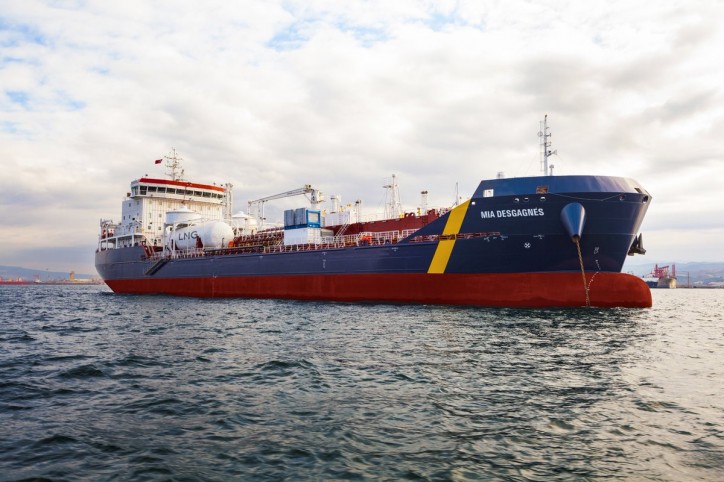Desgagnés christened and launched today the M/T Mia Desgagnés, the world's first polar-class dual-fuel oil/chemical tanker.
"Desgagnés is very proud to have achieved another world first in only a few short months," declared its president and CEO, Louis-Marie Beaulieu, recalling that last May, Desgagnés named the M/T Damia Desgagnés, the very first dual-fuel asphalt-bitumen-chemical tanker.

"The challenges and achievements don't stop at these world firsts," said Mr. Beaulieu since the Desgagnés Team had to meet a number of major challenges, including integrating the many innovations and new technologies on these vessels into its operations, developing a maritime LNG distribution network, almost inexistent up to that point, training a new class of qualified and certified sailors, and creating brand new training and certification programs. "It is thanks to the exceptional contribution and collaboration of various business partners, including Energir, the Montreal Port Authority, and Transport Canada, that allowed us to meet the challenges of this innovative project," noted Mr. Beaulieu.
In addition to being pioneering and innovative work, marking history, and transforming not only Desgagnés but also the industry, "the addition of the Mia Desgagnés to our fleet, just like the Damia Desgagnés, is a tangible demonstration of Desgagnés's vision and leadership in sustainable development, as well as its commitment to its customers to offer a top quality, safe and environmentally friendly marine transportation service for oil products," said Mr. Beaulieu.
The construction and commissioning of vessels such as the Mia Desgagnés are made possible because of major business partners and long-term contracts. "I would like to sincerely thank Valero Energy, a key player of capital importance, who has contributed in a tangible and very important way to the birth and development of our liquid bulk transportation business unit as well as to the completion of large-scale projects such as this one," said Mr. Beaulieu.

This vessel represents an investment of over $50 million, including nearly $9 million for the addition of dual-fuel/LNG motorization. "This is a very significant investment in line with our commitment to reduce our environmental footprint," added Mr. Beaulieu, who thanked the Quebec government for its financial contribution of $700,000 under its program to improve transportation efficiency and reduce greenhouse gas emissions (PETMAF).
The product/chemical tanker was christened Mia Desgagnés in the presence of numerous dignitaries and guests. Mia is a short form of Damia, and was chosen because originally the Mia was to be an asphalt-bitumen twin of the Damia Desgagnés, and means "drop of seawater" in Hebrew, which expresses the very essence of Desgagnés. Anne-Marie Cisotto Montgrain was chosen as godmother to the Mia Desgagnés because she has worked for many years at the company and embodies its values. She christened the ship, which was previously blessed by Father Aleksander Dudik, Vicar at the Mary Queen of the World Cathedral in Montreal.
The Mia Desgagnés has several sustainable development certifications, including "CLEANSHIPSUPER" and "GREEN PASSPORT"; but what sets her apart is her ability to run on three different types of fuel, including liquefied natural gas (LNG), which has undeniable environmental advantages, one of them being substantially reducing greenhouse gas emissions.
With a deadweight capacity of nearly 15,000 tons and tanks with a capacity exceeding 17,000 m³, the Mia Desgagnés is suitable for transporting refined petroleum products or chemicals. This next-generation, state-of-the-art ship was built at the Besiktas shipyard in Turkey using an original concept and specifications developed by Desgagnés to optimize safety, environmental performance, and operational efficiency.
The ship's double hull and Polar 7 certification guarantees her ability to navigate in ice. She's equipped with a variable pitch propeller as well as bow and stern thrusters providing exemplary maneuverability and an optimal level of safety. Her generators' power output of over 3 megawatts allows her, through her generator/motor integrated in the propulsion shaft, to reach a cruising speed of up to 7 knots without using the main engine. This flexibility further improves safety for the sailors, the environment, and the ship herself.
Source: Desgagnés